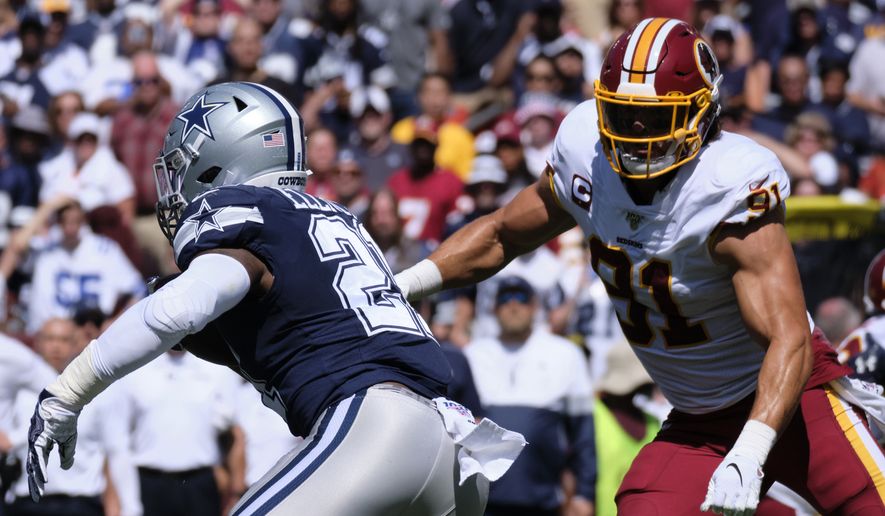ASHBURN — If the Redskins defense looked vanilla in Sunday’s 31-21 loss to the Dallas Cowboys, that was by design.
With a series of injuries in the secondary, last-minute replacements and five new starters picked up in the offseason, defensive coaches were trying to keep the game plan simple. The idea was that reducing the number of complex coverages would give the Redskins a chance to play more fundamentally sound defense than the unit did in Philadelphia to open the season.
It wasn’t enough.
“We wanted to challenge them and make them earn their grass,” coach Jay Gruden said. “Unfortunately, they did. We were a little bit more sound. We just didn’t make many plays.”
Through two games, Gruden said he sees no reason to “hit the panic button” after beginning the season 0-2 for the first time since 2016. And on Monday, the Redskins stuck to that train of thought. Defensive coordinator Greg Manusky still has his job. Gruden walk-backed a previous comment about the coaching staff not reaching his players.
But maybe, just maybe, there should be cause for alarm.
Not including the result of the Jets-Browns game on “Monday Night Football,” the Redskins have the second-worst defense in the league in terms of yards allowed. Only the hapless Miami Dolphins, who lost their first two games by a combined score of 102 to 10, have surrendered more.
The Redskins have given up 63 points and 910 yards. Their third-down defense, Gruden said, is “not good enough — in any league.”
When taking a look at every team’s first two games to start a season, the Redskins defense is historically bad on third down. The Eagles and the Cowboys converted a combined 18 third downs on 28 opportunities, good for an eye-popping 64% conversion rate.
That number isn’t just the worst in the team’s history, since third-down data started being tracked in 1991 — it’s the third-highest percentage of all-time.
The 1999 Browns, who finished 2-14, gave up about 66% (23 of 35) on third down, while the 2006 Houston Texans, who finished 6-10, conceded about 69% (17 of 25) of such plays. Again, these stats only factor in the first two games of every season, but history isn’t on the Redskins’ side when trying to turn things around. Right now, the Redskins’ third-down problems boil down to a lack of pass rush.
“It’s really not there,” Gruden said. ” … Maybe we’ve got to get some exotic looks to make the quarterback hold the ball a little bit longer to get home with the pressure. We’ve got to rush the passer, for sure. I think that’s the biggest challenge for our defensive line this week.”
The inability to generate pressure is baffling, given the resources the team put into the defensive line over the past few years. Even with Jonathan Allen’s knee injury, which kept him out against Dallas, the Redskins still have first-rounders Daron Payne and Montez Sweat upfront. Matt Ioannidis, who had 71/2 sacks last season, is an important contributor, too.
But so far, the Redskins have generated only two sacks, tied for the second-least in the league. According to Pro-Football-Reference, Washington has had just two quarterback hurries, three quarterback knockdowns and 10 blitzes. The Redskins prefer to generate pressure from the defensive line, but the unit hasn’t been good enough.
Perhaps not coincidentally, the Eagles’ Carson Wentz and the Cowboys’ Dak Prescott had their way with the Redskins. Together, they combined for a 124.8 passer rating — third highest in Redskins’ history through two games.
So, what’s the solution? Gruden said the Redskins have to “play better and demand more,” but it’s not that easy.
Since the NFL implemented a 16-game schedule in 1978, just 38 of 323 teams — or about 12% — have made the playoffs that began the season 0-2.
Cornerback Aaron Colvin has done it before. Last season with the Houston Texans, Colvin, who was acquired last week, saw his team go from 0-3 to 11-5 with a nine-game winning streak in between. The Texans made the playoffs and lost in the AFC wild card game.
“I know that the media and the fans don’t want hear that because they want to see, ’What can you do for me now?,’” Colvin said. “But in this locker room, we need to realize that it really isn’t over.”
• Matthew Paras can be reached at mparas@washingtontimes.com.




Please read our comment policy before commenting.